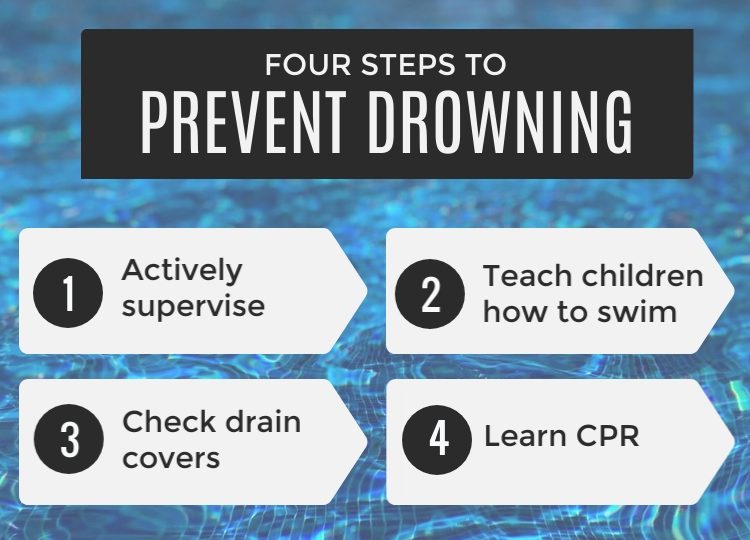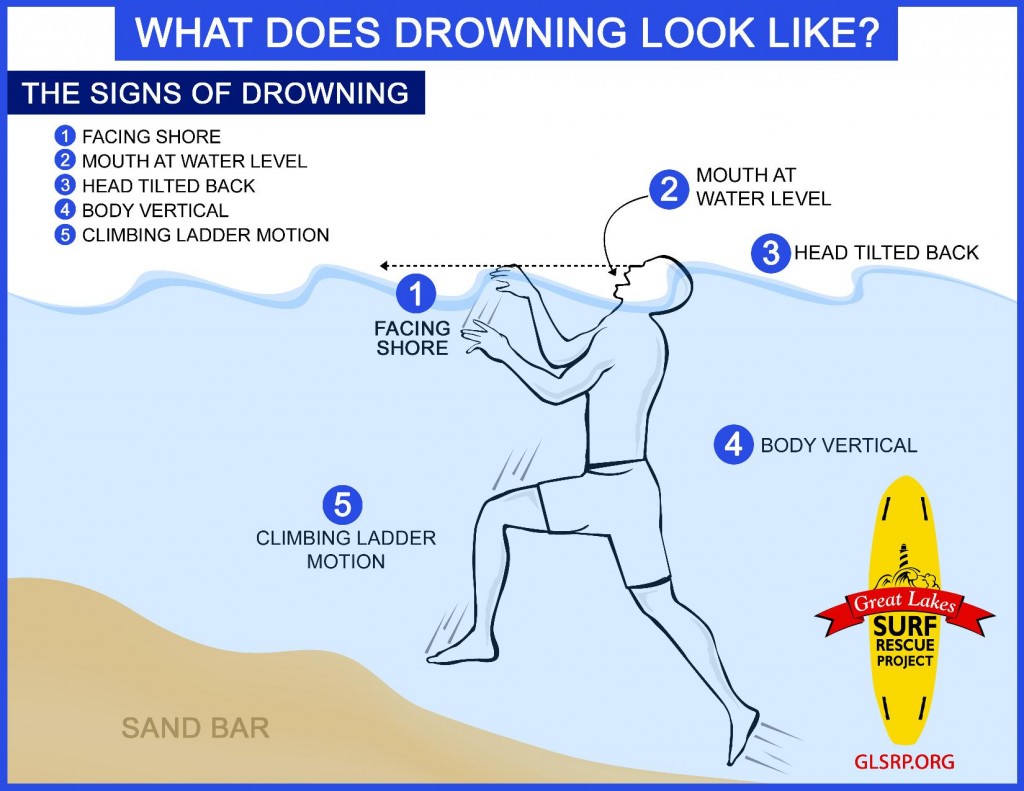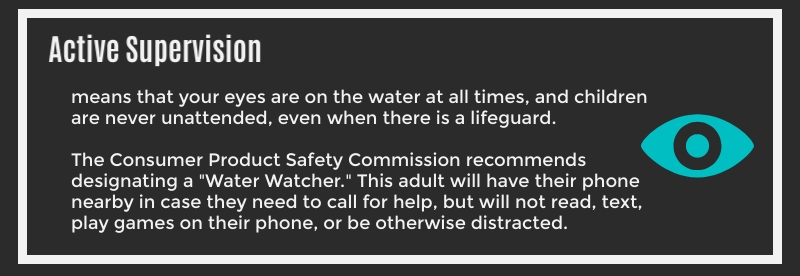What does drowning look like?
While movies and television often portray drowning with the victim thrashing their arms and yelling for help, this is not typically what drowning looks like. It is usually silent, with very little splashing. The Instinctive Drowning Response occurs when a person’s body reacts to the threat of suffocation in the water. It involves the following:
- Usually, drowning people are physically unable to call out for help, since their body is focused on breathing.
- Drowning people’s mouths typically bob above and below the surface of the water.
- Individuals who are drowning are not usually able to wave for help. The Instinctive Drowning Response forces them to use their arms to push down on the surface of the water, in an attempt to keep their head above water.
- Because their arms are used in the Instinctive Drowning Response, they also cannot grab onto a rescuer or rescue equipment.
- During the Instinctive Drowning Response, the drowning person’s body remains upright in a vertical position, and they do not kick their legs.
- People can only struggle this way for 20 to 60 seconds before they go under water for good.
Other Signs of Drowning:
Other signs of drowning or a person in distress are:
- Head low in the water, mouth at water level
- Head tilted back with mouth open
- Eyes glassy and empty, unable to focus
- Eyes closed
- Hair over forehead or eyes
- Not using legs to kick
- Vertical body position
- Hyperventilating or gasping
- Trying to swim in a particular direction but not making headway
- Trying to roll over on the back
- They appear to be trying to climb a ladder
Drowning Incident: What to do
If you notice any of these signs in a swimmer, refer to the Red Cross’s drowning chain of survival to get the person to safety:
- Recognize the signs of someone in trouble and shout for help.
- Rescue and remove the person from the water, if it is possible to do so without putting yourself in danger.
- Point to one person and tell them to call 911. If alone, do two minutes of rescue breathing and CPR and then call 911.
- Begin rescue breathing, then CPR.
- Use an AED if available and transfer care to EMS.
Even if removing the person from the water is all that is needed for the victim to regain consciousness, the rescuer should call 911 and the victim should be transported to a hospital for further evaluation.
For more information on the importance of learning CPR to water safety, visit our Lifesaving Skills page.

RESOURCES
- Drowning is a leading cause of death for children.
- While children are at highest risk, anyone can drown.
- Drowning can be fatal or nonfatal.
- Nonfatal drowning can result in long-term health problems and costly hospital stays.
- Learn more about current drowning rates. Read: Vital Signs: Drowning Death Rates, Self-Reported Swimming Skill, Swimming Lesson Participation, and Recreational Water Exposure — United States, 2019–2023
Learn more by visiting the CDC Drowning Facts webpage.
- Drowning is a major public health issue that can be prevented.
- More children ages 1–4 die from drowning than any other cause of death.
- Drowning happens in seconds and is often silent.
- Drowning can happen to anyone, any time there is access to water.
- You can prevent drowning.
- Drowning Prevention At-A-Glance PDF
Learn more by visiting the CDC Drowning Prevention webpage.
Most drownings involving young children occur in residential settings. Children under the age of five years do not struggle in the water. They can drown without making a sound.
Learn more by visiting the VDH Home and Recreational Safety Drowning Prevention webpage.
Drowning is one of the leading causes of unintentional death for children ages one through four.
Learn more by visiting the VDH Drowning in Virginia webpage.

Help prevent drowning:
Active supervision
- Watch kids closely when they are in or around water.
- Avoid distracting activities, like being on a phone. Drowning happens quickly and quietly.
- For preschool-aged children, “touch supervision” is recommended, where the supervising adult is within arm’s reach of the child.
- Consider having kids wear bright or neon colored swim suits that greatly contrast with the color of water. This may make them easier to see underwater.
- Learn more about Active Supervision.
- Watch this YouTube video on Active Supervision.
Learn to Swim
- Teach children basic swimming and water safety skills.
- Swimming lessons can reduce the risk of drowning.
- Consider enrolling children in swimming lessons. And consider swim lessons for yourself to improve your swimming skills and comfort in the water. It’s never too late to learn to swim and the benefits increase as we age. (CDC)
- While swimming lessons can contribute to water safety, they do not erase the risks of swimming. Conditions such as water temperature, air temperature, weather, water depth, water movement, and other factors can affect an individual’s swimming ability.
- Remember: Children who have had swimming lessons still need close and constant supervision when in or around water.
- Keep in mind that children who have had swimming lessons still need close and constant supervision when in or around water, even when a lifeguard is present.
- An adult should always be within an arm’s length from a child who is in or near water.
- When supervising children, a responsible adult should avoid distracting activities like reading, using the phone, and consuming alcohol or drugs because drowning happens quickly and quietly.
- Visit the CDC website to learn more about Summer Swim Safety.
- Watch this YouTube video on Learning to Swim.
Check Drain Covers
- Staying away from drain covers, skimmers, or pipes can prevent entrapment from suction.
- Watch this YouTube video on Drain Covers.
Learn CPR
- Learn CPR by getting trained. Contact the American Red Cross or other community organization to find CPR lessons near you.
- If drowning has occurred and the victim is not breathing, bystander-initiated CPR is the most effective way to promote a positive outcome.
- Watch this YouTube video on CPR.
For more information on the importance of learning CPR to water safety, visit our Lifesaving Skills page.





